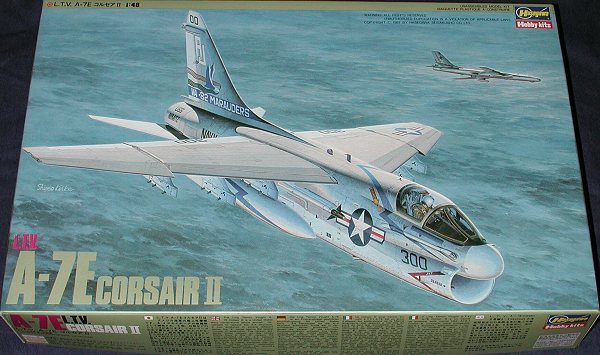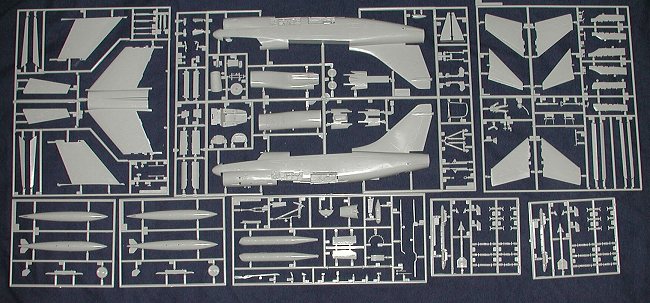
| KIT: | Hasegawa 1/48 A-7E Corsair II |
| KIT # | P 12 |
| PRICE: | $39.95 |
| DECALS: | Two Aircraft |
| REVIEW & | |
| NOTES: |

| HISTORY |
The A-7 Corsair II was designed as a replacement for the A-4 Skyhawk in the light attack role. The first versions, the A-7A was in fleet service in the late 1960s and by the end of the Vietnam War had nearly completely replaced the Skyhawk. As nice as the A-7A was, it had some problems, including a less than totally reliable engine and very weak brakes.
The USAF was also interested the the A-7, but wanted a better engine, specifically the TF41 that provided more power and better reliability. The also wanted to use the M61A1 'Vulcan' multibarrel 20mm gatling gun in place of the twin 20mm single barrel cannon used on the earlier A-7s. They also wanted the USAF style in-flight refueling receptacle.
The Navy decided to adopt this variant, though with the USN refueling probe and USN electronics as the A-7E. It was this version that served well into the early 1990, finally retiring just after Desert Storm in 1991. Surviving light attack A-7 squadrons were replaced with F-18 Hornets as were any reserve units that escaped the huge drawdown in the early 1990s.
| THE KIT |

There have been about three 1/48 A-7 kits on the market. The first is the ancient Aurora kit which was modified later by Monogram and is still the only A-7A on the market. However, it has some real shape problems, mostly in the intake, a shape that has been difficult for most kit makers to get right regardless of the scale. Next was the ESCI A-7E. This kit is a real mess and best avoided altogether, though your editor wasted valuable modeling time and lots of filler on one reviewed here in M2.
The third kit is the Hasegawa 1/48 version. This has been released as either an A-7D or A-7E and came out around 1987 or so. This is by far the best one available and is fully up to modern standards with engraved panel lines and the required detail in the cockpit and wheel wells. Options are for an open or closed canopy, folded wings, lowered or raised slats and flaps and speed brake (which is almost never deployed on the ground), open or closed boarding steps/ladder and open or closed fuselage avionics bays. Under wing things include twin fuel tanks, a pair of MER's (no ordnance, though) and a FLIR pod that wasn't carried that often. It also has fuselage mounted Sidewinder rails and a pair of Sidewinders to go on them. While the A-7 almost always carried the wing racks, they didn't always carry the Sidewinder rails. If you do not use the FLIR pod, then the fuel tanks will go on the inner wing pylons.
 Instructions are the typically super ones from Hasegawa. They give the usual clear instruction steps and Gunze Sangyo paint references. FS 595a paint numbers are given where appropriate. You get two different aircraft on the decal sheet, both of them in the gloss light gull grey over white scheme. Not surprisingly, one is for VA-93 from CAG 5, then aboard the USS Midway. This is an often decaled scheme because of the sharkmouth design. The other is from VA-82, the Marauders' aboard the USS Nimitz. Both are CAG birds, though only the VA-82 one has multiple colors in its scheme. The decals themselves are well printed, but a bit thick. A bunch of data decals are also included. The sheet is so large that it didn't completely fit on my scanner bed!
Instructions are the typically super ones from Hasegawa. They give the usual clear instruction steps and Gunze Sangyo paint references. FS 595a paint numbers are given where appropriate. You get two different aircraft on the decal sheet, both of them in the gloss light gull grey over white scheme. Not surprisingly, one is for VA-93 from CAG 5, then aboard the USS Midway. This is an often decaled scheme because of the sharkmouth design. The other is from VA-82, the Marauders' aboard the USS Nimitz. Both are CAG birds, though only the VA-82 one has multiple colors in its scheme. The decals themselves are well printed, but a bit thick. A bunch of data decals are also included. The sheet is so large that it didn't completely fit on my scanner bed!
| CONCLUSIONS |
Overall, if you want a 1/48 A-7E, then this is really the only logical choice. There are oodles of aftermarket bits and decals available for the kit. The only one I'd say you might really need are a Seamless Suckers intake as sanding the seam off the kit intake will be a real challenge!
Review kit courtesy of me and my wallet!
If you would like your product reviewed fairly and fairly quickly by asite that has thousands of visits a day, please contactme or see other details in the